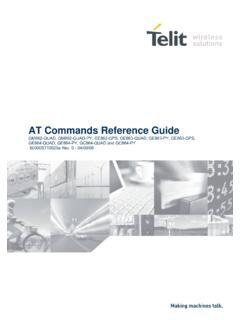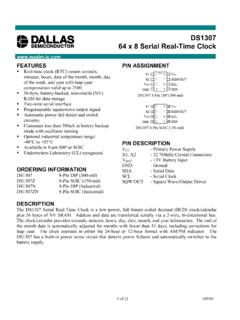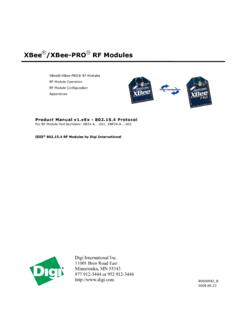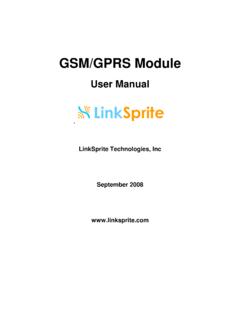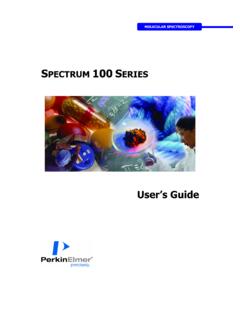Transcription of Datasheet SHT1x (SHT10, SHT11, SHT15) Humidity and ...
1 Version July 2008 Datasheet SHT1x (SHT10, SHT11, SHT15) Humidity and Temperature Sensor Fully calibrated Digital output Low power consumption Excellent long term stability SMD type package reflow solderable Dimensions Figure 1: Drawing of SHT1x sensor packaging, dimensions in mm (1mm = ). Sensor label gives 11 for SHT11 as an example. Contacts are assigned as follows: 1:GND, 2:DATA, 3:SCK, 4:VDD. Sensor Chip SHT1x V4 for which this Datasheet applies features a version 4 Silicon sensor chip. Besides a Humidity and a temperature sensor the chip contains an amplifier, A/D converter, OTP memory and a digital interface. V4 sensors can be identified by the alpha=numeric traceability code on the sensor cap see example A5Z code on Figure 1. Material Contents While the sensor is made of a CMOS chip the sensor housing consists of an LCP cap with epoxy glob top on an FR4 substrate.
2 The device is fully RoHS and WEEE compliant, thus it is free of Pb, Cd, Hg, Cr(6+), PBB and PBDE. Evaluation Kits For sensor trial measurements, for qualification of the sensor or even experimental application of the sensor there is an evaluation kit EK-H2 available including sensor, hard and software to interface with a computer. For more sophisticated and demanding measurements a multi port evaluation kit EK-H3 is available which allows for parallel application of up to 20 sensors. Product Summary SHT1x (including SHT10, SHT11 and SHT15) is Sensirion s family of surface mountable relative Humidity and temperature sensors. The sensors integrate sensor elements plus signal processing on a tiny foot print and provide a fully calibrated digital output. A unique capacitive sensor element is used for measuring relative Humidity while temperature is measured by a band=gap sensor.
3 The applied CMOSens technology guarantees excellent reliability and long term stability. Both sensors are seamlessly coupled to a 14bit analog to digital converter and a serial interface circuit. This results in superior signal quality, a fast response time and insensitivity to external disturbances (EMC). Each SHT1x is individually calibrated in a precision Humidity chamber. The calibration coefficients are programmed into an OTP memory on the chip. These coefficients are used to internally calibrate the signals from the sensors. The 2=wire serial interface and internal voltage regulation allows for easy and fast system integration. The tiny size and low power consumption makes SHT1x the ultimate choice for even the most demanding applications. SHT1x is supplied in a surface=mountable LCC (Leadless Chip Carrier) which is approved for standard reflow soldering processes.
4 The same sensor is also available with pins (SHT7x) or on flex print (SHTA1). A5Z 1 2 NC NC NC NC NC NC sensor opening 3 4 11 MAX MAX Datasheet SHT1x Version July 2008 2/11 Sensor Performance relative Humidity123 Parameter Condition min typ max Units %RH Resolution 1 8 12 12 bit typical %RH Accuracy 2 SHT10 maximal see Figure 2 typical %RH Accuracy 2 SHT11 maximal see Figure 2 typical %RH Accuracy 2 SHT15 maximal see Figure 2 Repeatability %RH Replacement fully interchangeable Hysteresis 1 %RH raw data 3 %RH Nonlinearity linearized <<1 %RH Response time 3 (63%) 8 s Operating Range 0 100 %RH Long term drift 4 normal < %RH/yr SHT11 SHT15 SHT10 0 2 4 6 8 100 10 20 30 40 50 60 70 80 90 100 relative Humidity (%RH) RH (%RH)
5 Figure 2: Maximal RH=accuracy at 25 C per sensor type. Electrical and General Items Parameter Condition min typ max Units Source Voltage V sleep 2 5 NW measuring 3 mW Power Consumption 5 average 150 NW Communication digital 2=wire interface, see Communication Storage 10 50 C (0 125 C peak), 20 60%RH 1 The default measurement resolution of is 14bit for temperature and 12bit for Humidity . It can be reduced to 12/8bit by command to status register. 2 Accuracies are tested at Outgoing Quality Control at 25 C (77 F) and Values exclude hysteresis and non=linearity. 3 Time for reaching 63% of a step function, valid at 25 C and 1 m/s airflow. Temperature45 Parameter Condition min typ max Units C Resolution 1 12 14 14 bit typical C Accuracy 2 SHT10 maximal see Figure 3 typical C Accuracy 2 SHT11 maximal see Figure 3 typical C Accuracy 2 SHT15 maximal see Figure 3 Repeatability C Replacement fully interchangeable =40 C Operating Range =40 F Response Time 6 (63%) 5 30 s Long term drift < C/yr SHT11 SHT15 SHT10 =20020406080 100 Temperature ( C) T ( C)Figure 3: Maximal T=accuracy per sensor type.
6 Packaging Information Sensor Type Packaging Quantity Order Number SHT10 Tape & Reel 2000 1=100218=04 Tape & Reel 100 1=100051=04 Tape & Reel 400 1=100098=04 SHT11 Tape & Reel 2000 1=100524=04 Tape & Reel 100 1=100085=04 SHT15 Tape & Reel 400 1=100093=04 4 Value may be higher in environments with high contents of volatile organic compounds. See Section of Users Guide. 5 Values for VDD= at 25 C, average value at one 12bit measurement per second. 6 Response time depends on heat capacity of and thermal resistance to sensor substrate. Version July 2008 Users Guide SHT1x 1 Application Information Operating Conditions Sensor works stable within recommended normal range see Figure 4. Long term exposures to conditions outside normal range may temporarily offset the RH signal (+3 %RH after 60h).
7 After return to normal range it will slowly return towards calibration state by itself. See Section Reconditioning Procedure to accelerate eliminating the offset. Prolonged exposure to extreme conditions may accelerate ageing. Max. RangeNormal Range020406080100=40 =20 020 40 60 80 100 120 Temperature ( C) relative Humidity (%)Figure 4: Operating Conditions Soldering instructions For soldering SHT1x standard reflow soldering ovens may be used. The sensor is qualified to withstand soldering profile according to IPC/JEDEC J=STD=020C with peak temperatures at 260 C during up to 40sec including Pb=free assembly in IR/Convection reflow ovens. Figure 5: Soldering profile according to JEDEC standard. TP <= 260 C and tP < 40sec for Pb=free assembly. TL < 220 C and tL < 150sec. Ramp=up/down speeds shall be < 5 C/sec. For soldering in Vapor Phase Reflow (VPR) ovens the peak conditions are limited to TP < 233 C during tP < 60sec and ramp=up/down speeds shall be limited to 10 C/sec.
8 For manual soldering contact time must be limited to 5 seconds at up to 350 C7. 7 233 C = 451 F, 260 C = 500 F, 350 C = 662 F IMPORTANT: After soldering the devices should be stored at >75%RH for at least 12h to allow the polymer to re=hydrate. Otherwise the sensor may read an offset that slowly disappears if exposed to ambient conditions. In no case, neither after manual nor reflow soldering, a board wash shall be applied. Therefore it is strongly recommended to use no=clean solder paste. In case of application with exposure of the sensor to corrosive gases the soldering pads shall be sealed to prevent loose contacts or short cuts. For the design of the SHT1x footprint it is recommended to use dimensions according to Figure 7. Sensor pads are coated with 35Sm Cu, 5Sm Ni and Au.
9 Figure 6: Rear side electrodes of sensor, view from top side. Figure 7: Recommended footprint for SHT1x . Values in mm. Storage Conditions and Handling Instructions It is of great importance to understand that a Humidity sensor is not a normal electronic component and needs to be handled with care. Chemical vapors at high concentration in combination with long exposure times may offset the sensor reading. For these reasons it is recommended to store the sensors in original packaging including the sealed ESD bag at following conditions: Temperature shall be in the range of 10 C 50 C (0 125 C for limited time) and Humidity at 20 60%RH (sensors that are not stored in ESD bags). No copper in this field Temperature Time tP TP TL TS (max) tL preheating critical zone Datasheet SHT1x Version July 2008 4/11 For sensors that have been removed from the original packaging we recommend to stored them in ESD bags made of PE=HD8.
10 In manufacturing and transport the sensors shall be prevented of high concentration of chemical solvents and long exposure times. Out=gassing of glues, adhesive tapes and stickers or out=gassing packaging material such as bubble foils, foams, etc. shall be avoided. Manufacturing area shall be well ventilated. For more detailed information please consult the document Handling Instructions or contact Sensirion. Reconditioning Procedure As stated above extreme conditions or exposure to solvent vapors may offset the sensor. The following reconditioning procedure may bring the sensor back to calibration state: Baking: 100 105 C at < 5%RH for 10h Re=Hydration: 20 30 C at ~ 75%RH for 12h 9. Temperature Effects relative Humidity reading strongly depends on temperature. Therefore, it is essential to keep Humidity sensors at the same temperature as the air of which the relative Humidity is to be measured.
